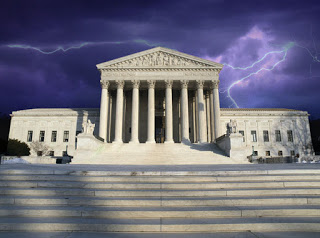By: The Editorial Board – wsj.com – December 20, 2021
Judges Julia Smith Gibbons and Jane Branstetter Stranch rescued the mandate by deferring to the Administration. They say Congress gave OSHA the power to issue emergency orders to protect workers from “grave dangers.” The Labor Secretary merely must find “that employees are exposed to grave danger from exposure to substances or agents” that are toxic or physically harmful and that an “emergency standard is necessary to protect employees from such danger.”
Covid meets the dictionary definition of an “agent,” the majority says, ergo OSHA can issue its mandate. The majority also says new variants support OSHA’s determination that Covid still poses a grave danger, and it is not “appropriate to second-guess that agency determination considering the substantial evidence, including many peer-reviewed scientific studies, on which it relied.”
But the question the judges are asked to decide isn’t whether Covid is a grave danger, as Judge Joan Larsen explains in her potent dissent. The question is whether OSHA acted within the law as written by Congress. It certainly didn’t as we read the law.
For starters, the Labor Secretary must show that an emergency temporary standard is “necessary” to protect workers from a grave danger—not merely “reasonably necessary or appropriate.” OSHA argues its mandate is effective and useful, but this is irrelevant.
OSHA waited nearly a year after vaccines became available to issue its sweeping rule. The agency also didn’t attempt to calculate the number of Americans who have contracted Covid at work or identify a particular risk of workplace exposure. OSHA claims workplaces in general are risky and unvaccinated workers in general are at high risk. But some workers at some workplaces have a higher risk of contracting the virus and getting severely ill.
“The government’s own data reveal that the death rate for unvaccinated people between the ages of 18 and 29 is roughly equivalent to that of vaccinatedpersons between 50 and 64,” Judge Larsen notes. OSHA is obligated by administrative law to consider more tailored alternatives, and it did not.
The Supreme Court’s major questions doctrine says Congress must “speak clearly if it wishes to assign to an agency decisions of vast ‘economic and political significance.’” Congress also cannot delegate sweeping legislative power to regulators.
The agency has only issued 10 emergency temporary standards in 50 years—six were challenged in court and five were struck down—but all involved discrete illnesses in particular industries. “This emergency rule remains a massive expansion of the scope of its authority,” Judge Larsen writes, comparing it to the Centers for Disease Control and Prevention’s eviction moratorium that the Supreme Court struck down.
***
Businesses have appealed the Sixth Circuit’s vaccine decision directly to the High Court. The Biden Administration has also asked the Court to stay lower-court decisions enjoining its vaccine mandate for healthcare workers.
This is an important moment for the Court. Chief Justice John Roberts and Justices Brett Kavanaugh and Amy Coney Barrett have declined to enjoin New York’s and Maine’s healthcare-worker vaccine mandates that deny religious, but not medical, exemptions. Some Justices may want to defer to regulators on health and safety during the pandemic.
But the separation of powers is crucial to safeguarding individual liberty. Justices now have two key tests on whether they will rein in the administrative state. They will have to decide if they take their major question and non-delegation doctrines seriously, or are they merely seminars at the Federalist Society?
To see this article and subscribe to others like it, choose to read more.
 Listen Online
Listen Online Watch Online
Watch Online Find a Station in Your Area
Find a Station in Your Area







 Listen Now
Listen Now Watch Online
Watch Online
